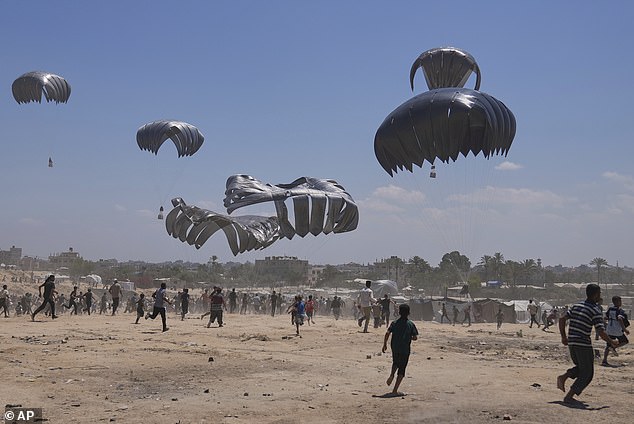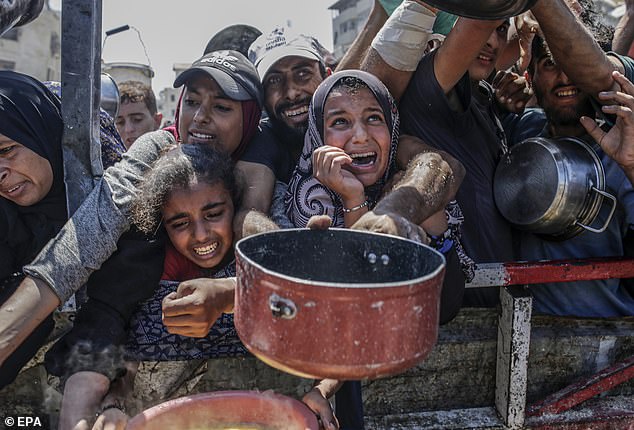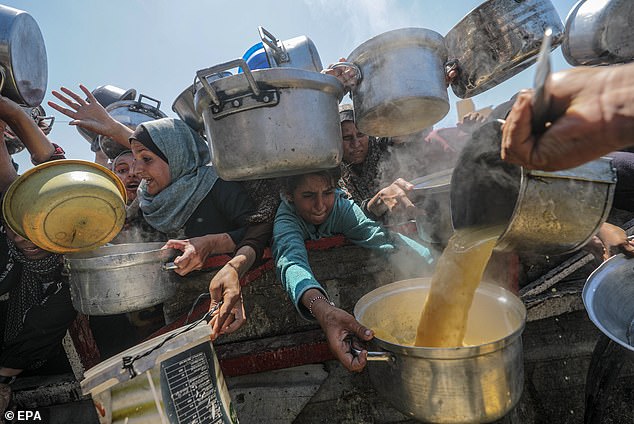The majority of the aid sent to Gaza is being intercepted by armed militants and desperate civilians before it reaches its intended target, official figures show.
Data from the UN shows that just 14 per cent of the pallets collected at the Gaza border arrived safely at their destination.
The rest (86 per cent) were intercepted – ‘either peacefully by hungry people or forcefully by armed actors, during transit in Gaza’, the UN said.
The UN agency for Palestinian refugees, UNRWA, has previously accused armed militias of looting the aid convoys at gunpoint.
Figures show that of the 29,885 aid pallets collected for delivery in Gaza between mid-May and last weekend, 25,703 were taken en route.
It means only 4,182 pallets containing vital supplies intended for Gaza’s desperately hungry inhabitants made it safely to the destination.
The UN is unable to break down how much of the missing aid – equating to 23,353 tons in the last two and a half months – has been snatched by Hamas militants, or taken by some of the more than two million people living in Gaza’s warzone.
But the figures underline the gravity of the humanitarian crisis with both Hamas and Israel blaming each other.

Palestinians rush to collect aid dropped by parachutes

Hungry Gazans scramble to get food. At least 175 people – including 93 children – have now died from starvation in Gaza since the war began, according to figures from the Hamas-run health ministry

Food is distributed to Palestinians as both Hamas and Israel blame each other for the humanitarian crisis in Gaza
Charities operating in the disaster zone last night laid bare the extent to which Gaza’s civilian population was struggling.
Sarah Davies, who is based in Jerusalem for the International Committee of the Red Cross, said: ‘Regardless of how many trucks enter Gaza, the critical issue is whether aid actually reaches the people who need it.
‘Right now, that is not happening at the scale required.
‘At the Red Cross Field Hospital, we are treating more patients showing signs of malnutrition, which delays recovery and particularly affects children’s development and wellbeing.
‘We are also facing challenges in replenishing basic medical items and consumables at the rate they are being used. Given the rising number of weapon-wounded patients, materials such as bandages, IV fluids, surgical gloves and other essentials are being depleted rapidly.
‘We’ve seen a significant increase in the number of patients arriving after being wounded who tell us they were injured while attempting to access food at distribution points. Some tragically did not survive, or are declared dead on arrival.
‘We have consistently emphasised that bringing aid into Gaza is only one part of the equation. The aid must be able to be moved safely and swiftly to reach vulnerable patients in hospitals, the elderly, children and pregnant women. That is not happening nearly enough today.’
A spokesman for Doctors Without Borders (MSF) said its health facilities in the region had received ‘hundreds of people wounded or killed while simply trying to find something to eat’.
They said: ‘Very little food is entering the Gaza Strip, nowhere near enough to feed two million people.
‘The few boxes that do enter rarely make it to people in need. And those that manage to reach people in need are systematically accompanied by bloodbaths, either from the chaos of the situation itself, or because Israeli forces and US security contractors are shooting at crowds.
‘Regardless of where and how this massive loss of life is happening, regardless of who is pulling the trigger, the conditions of desperation and suffering that we are witnessing first-hand in Gaza have been engineered by Israeli authorities against its obligations as occupying power, which include the obligation to ensure humanitarian action is protected.
‘We need aid to be allowed in, at scale, with guarantees that convoys will reach people in need safely, and we need a full return to the UN-led independent humanitarian mechanism.’
At least 175 people – including 93 children – have now died from starvation in Gaza since the war began following the Hamas attacks on October 7 2023, according to figures from the Hamas-run health ministry.
Data shows the vast majority (98.6 per cent) of the pallets contain food. The remainder of the aid comprises fuel, health supplies and other forms of nutrition.
Most of the aid (90 per cent) comes from the UN’s World Food Programme, with the World Central Kitchen (6.5 per cent) and Unicef (2.1 per cent) among the next biggest suppliers.
Hospital officials in Gaza said at least a further 23 Palestinians were shot dead by Israeli forces as hungry crowds sought out food.
Witness Yousef Abed described coming under what he called indiscriminate fire, looking around and seeing at least three people bleeding on the ground.
He said: ‘I couldn’t stop and help them because of the bullets.’
The UN reported 859 people were killed near aid sites from May 27 to July 31, and hundreds more have been killed along the routes of UN-led food convoys.












